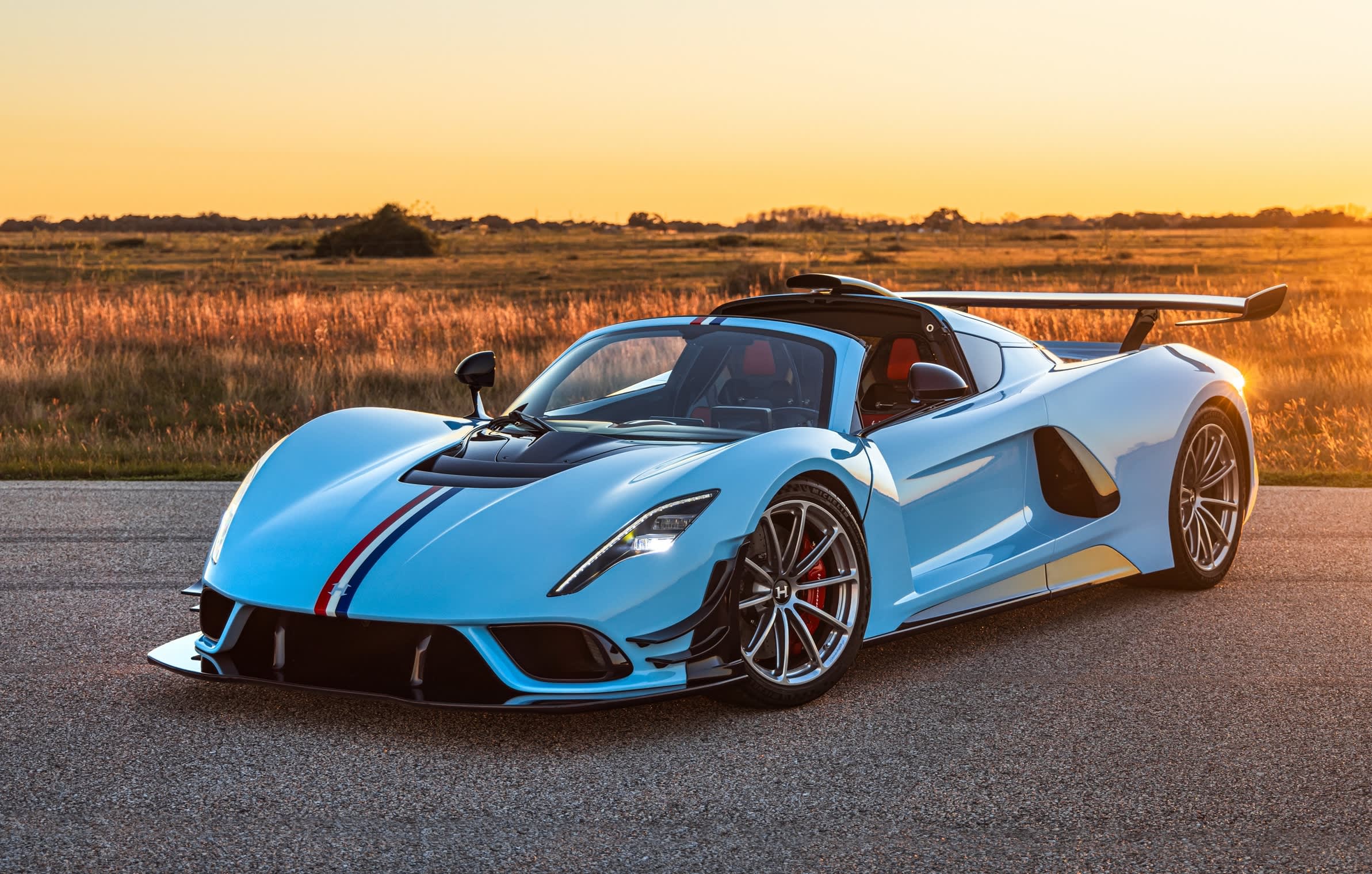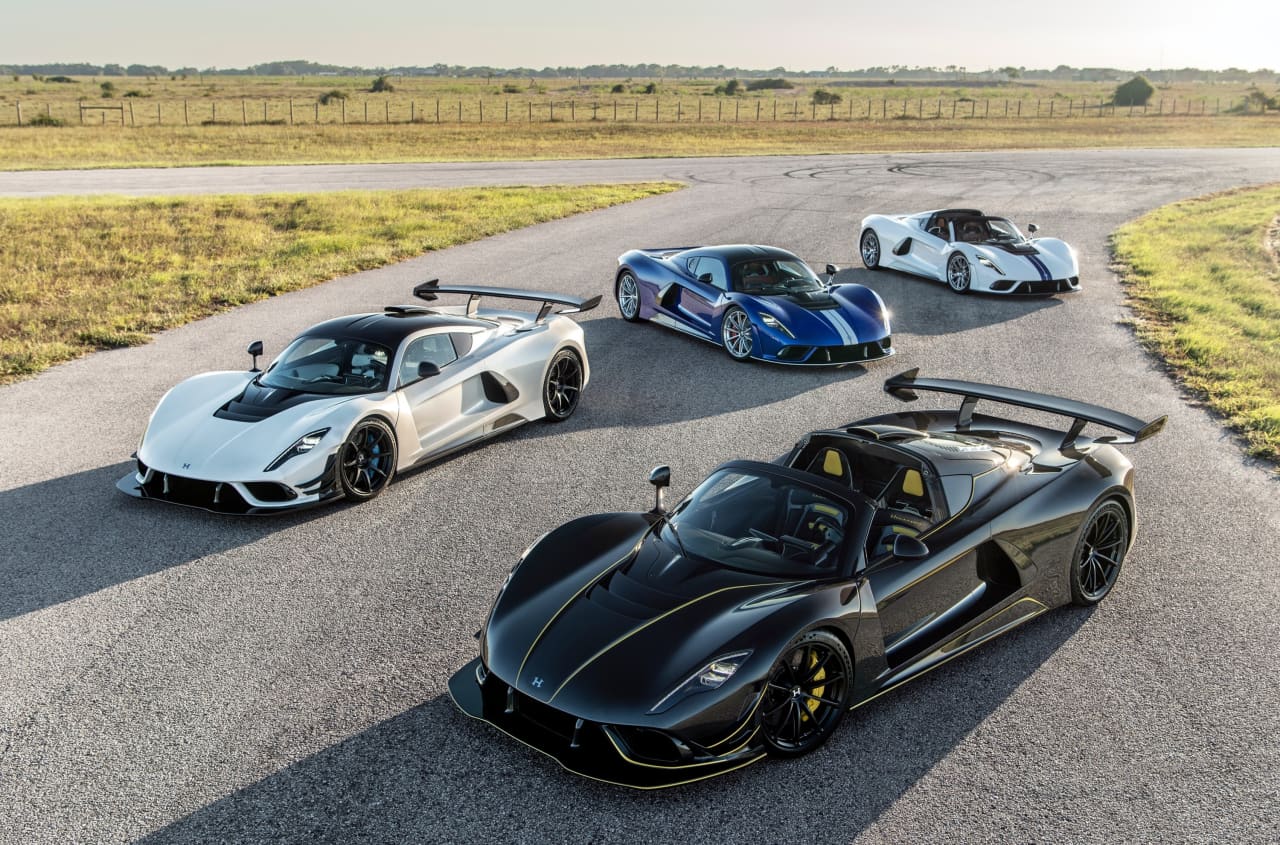A Texas-Built Hypercar, the 300 MPH Hennessey Venom, Is in the Running for the World’s Fastest Production Car
There are Corvette fans for whom the base US$68,300 car is plenty powerful enough. After all, it produces 495 horsepower and can reach 60 miles per hour in 2.9 seconds. But hold on, there’s also the approximately US$115,000 Z06—with 670 horsepower and able to reach 60 in 2.6 seconds. These split seconds are important for busy people—and for marketing claims. And if that’s not enough go power, there’s the even more formidable 900-horsepower ZR1 version of the Corvette, starting around US$150,000. The hybrid E-Ray, at US$104,900, is pretty potent, too.
But if they’re still too slow, fans of American-engineered muscle can consider the exclusive Texas-built Hennessey Venom F5, a limited-edition carbon-fibre hypercar. Ten years ago, the Hennessey became the world’s fastest production car, defeating the Bugatti Veyron Super Sport, with a top speed of 270.49 miles per hour.
That world title is much sought after, and is currently held by the Sweden-built 1,600-horsepower Koenigsegg Jesko Absolut, with a two-way average top speed of 277.8 mph. But Hennessey is still very much a contender. The company is hoping the 1,817-horsepower F5 (with 1,192 pound-feet of torque) can exceed 300 mph on the track this year.

Hennessey photo
Hennessey’s previous Venom GT model (introduced in 2010) was based on the Lotus Exige, with a GM LS-based engine, and was built by partner Delta Motorsport. Spokesman Jon Visscher tells Penta , “The new Venom F5, revealed in 2020, is a 100%bespoke creation—unique to Hennessey and featuring a Hennessey-designed 6.6-litre twin-turbo V8 engine boasting 1,817 horsepower, making it the world’s most powerful combustion-engine production car.” Leaps in performance like this tend to be pricey.
This is a very exclusive automobile, priced around US$2.5 million for the coupe, and US$3 million for the F5 Roadster announced in 2023. Only 30 Roadsters will be built, with a removable carbon-fiber roof. The 24 F5 coupes were spoken for in 2021, but if you really want one you could find a used example—or go topless. In a statement to Penta , company founder and CEO John Hennessey said that while the coupe “is now sold out, a handful of build slots remain for our Roadster and [track-focused] Revolution models.”
Only 24 Revolutions will be built in coupe form, priced at US$2.7 million. There’s also a rarefied roadster version of the Revolution, with just 12 to be built.

Hennessey photo
The Venom F5 coupe weighs only 3,000 pounds, and it’s not surprising that insane speeds are possible when combined with a hand-built motor (nicknamed “Fury”) created with power uppermost. The V8 in the F5, installed in a rear mid-engine configuration, has a custom engine block and lightweight forged aluminium pistons, billet-steel crankshaft, and forged-steel connecting rods. Twin turbochargers are featured. The F5 can reach 62 mph in less than three seconds, but top speed seems to be its claim to fame.
The driver shifts the rear-wheel-drive car via a seven-speed, single-clutch transmission with paddle shifters. The interior is not as spartan or as tight as in many other supercars, and is able to handle very tall people. The butterfly doors lift up for access.
“With 22 customer Venom F5 hypercars already delivered to customers around the world, and a newly expanded engineering team, we’re focusing the Venom F5 on delivering on its potential,” Hennessey says. “Breaking 300 mph in two directions is the goal we aim to achieve toward the end of this year to claim the ‘world’s fastest production car’ title.”
Hennessey says the car and team are ready. “Now the search is on for a runway or public road with a sufficiently long straight to allow our 1,817-horsepower, twin-turbo V8 monster to accelerate beyond 300 mph and return to zero safely.” The very competitive Hennessey said the track-focused Revolution version of the F5 set a fastest production car lap around Texas’ 3.41-mile Circuit of the Americas track in March, going almost seven seconds faster than a McLaren P1.
The Revolution features a roof-mounted central air scoop (to deliver cool air to the engine bay), a full-width rear carbon wing, larger front splitter and rear diffuser, tweaked suspension, and engine cooling. It’s got the same powertrain as the standard cars, but is enhanced to stay planted at otherworldly speeds.
 Copyright 2020, Dow Jones & Company, Inc. All Rights Reserved Worldwide. LEARN MORE
Copyright 2020, Dow Jones & Company, Inc. All Rights Reserved Worldwide. LEARN MORE
Hand-built in Melbourne and limited to just 10 cars a year, the Zeigler/Bailey Z/B 4.4 is reshaping what a modern collector car can be.
Three completed developments bring a quieter, more thoughtful style of luxury living to Mosman, Neutral Bay and Crows Nest.
Hand-built in Melbourne and limited to just 10 cars a year, the Zeigler/Bailey Z/B 4.4 is reshaping what a modern collector car can be.
In a quiet workshop in inner city Melbourne, one of the most ambitious performance cars in Australia is being built by hand.
Limited to just 10 cars a year and priced at $1.6 million, the Zeigler/Bailey Z/B 4.4 is not designed to chase mass appeal.
It is built for a very specific kind of driver. One who wants feel over flash, engineering over hype, and a car with soul as well as speed.
The Z/B 4.4 takes visual cues from the classic air-cooled Porsche era of the late 1970s and 80s, but beneath the familiar silhouette sits an entirely new platform.
Rather than restoring or lightly modifying an old chassis, the team has replaced the floor and structure with a clean-sheet, motorsport-bred tub, engineered to modern Australian safety standards and designed to work in both right- and left-hand drive.
The result is a car that looks nostalgic, but behaves like a thoroughly modern performance machine.
Power comes from a bespoke 4.4-litre air-cooled flat-six engine, designed and assembled in-house and machined from solid aluminium billet.

With 300 kilowatts of power and 500 Newton-metres of torque, its output slightly surpasses that of today’s Porsche 911 Carrera, while retaining the raw sound and character of classic air-cooled engineering.
Much of the car’s suspension architecture is inspired by Le Mans prototype racing, with push-rod actuated dampers and a multi-link rear system designed to deliver both comfort and precision.
The electronics have also been built from scratch, using a solid-state CAN-bus architecture that allows for digital instrumentation, remote diagnostics and ongoing software updates.
Every Z/B 4.4 begins life as a donor Porsche 911 from the 1975 to 1989 G-series era. From there, almost everything mechanical, structural and electronic is reimagined. More than 3,500 bespoke parts go into each finished car.
Despite the engineering depth, this is not a track-only machine.
Owners are involved in the personalisation of colour, trim and finishes, with many choosing to take part in selected phases of the build itself. Seating, ride settings, digital displays and even engine tuning can all be adjusted to suit the driver.
Behind the project are entrepreneur and Porsche collector John Zeigler Jr and automotive engineer Greg Bailey.
Together, they have created not just a car, but a global low-volume manufacturing model, using advanced CNC machining and 3D printing to produce parts that would once have been impossible to fabricate locally.
The business now employs a specialised team of designers, engineers and assemblers, and has plans to scale internationally through engines, components and licensed assembly.
For collectors, the appeal is as much about rarity as performance. Only 10 cars a year will be built for the Australian market. Six are already sold. Delivery from order is about 12 months.
In a world where hypercars increasingly blur into one another, the Z/B 4.4 stands apart as something deeply personal and proudly Australian. It is not designed to dominate social media feeds or sit under velvet ropes. It is designed to be driven.
As the creators like to say, you do not buy cool. You build it.
An opulent Ryde home, packed with cinema, pool, sauna and more, is hitting the auction block with a $1 reserve.
A cluster of century-old warehouses beneath the Harbour Bridge has been transformed into a modern workplace hub, now home to more than 100 businesses.























